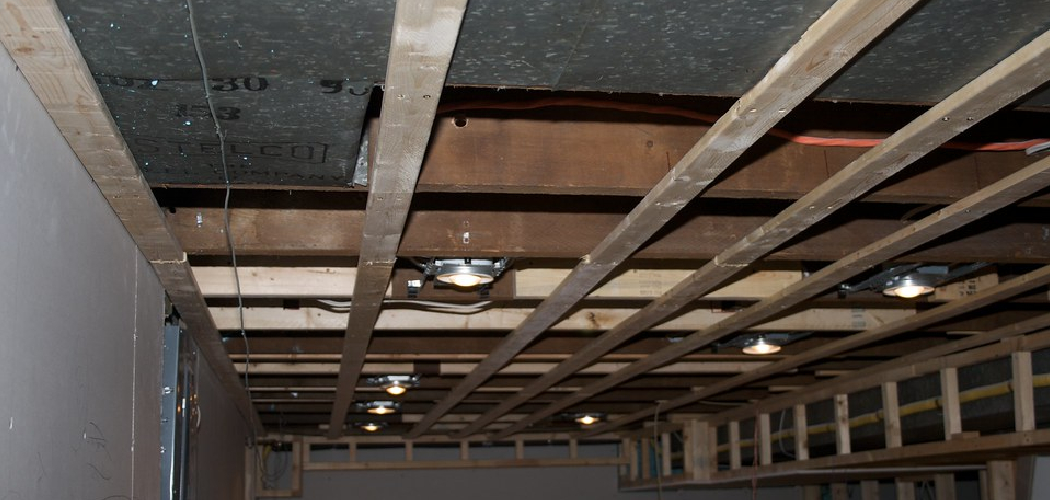Covering a basement ceiling is an important aspect of basement finishing and renovation projects. A finished basement not only adds value to your home, but it also provides additional living space for you and your family.

A major concern when covering a basement ceiling is the unsightly appearance of exposed ductwork, pipes, wiring, and insulation. These components can ruin the look of a newly finished basement, making it look unfinished and uninviting.
The main advantage of covering a basement ceiling is to improve the overall appearance of the space. Many basements have exposed pipes, wires, and ductwork that can be unsightly and give off an unfinished feel. By covering the ceiling, these elements can be hidden and create a more polished look. Read this blog post to learn how to cover basement ceiling.
Step-by-step Instructions for How to Cover Basement Ceiling
Step 1: Inspect and Clean the Ceiling
To start, you’ll want to thoroughly inspect your basement ceiling. Look for any signs of water damage or other issues that may need to be addressed before proceeding. Once you’ve checked the ceiling for any potential problems, it’s time to clean it. Use a vacuum cleaner with an extension wand attachment to remove any dust, cobwebs, or debris from the ceiling.
Step 2: Measure and Plan
Once the ceiling is clean, it’s time to measure and plan out your project. Start by measuring the dimensions of your basement ceiling so you know how much material you will need. This will also help you determine the layout for your ceiling tiles or panels.
There are various materials available for covering basement ceilings, such as ceiling tiles, drywall, beadboard, or paintable wallpaper. Consider factors such as durability, ease of installation, and cost when making your decision.
Step 3: Gather Necessary Tools
Before you begin installing your chosen covering material, make sure you have all the necessary tools on hand. This may include a ladder, measuring tape, level, drill, screws, and a saw for cutting materials to size.
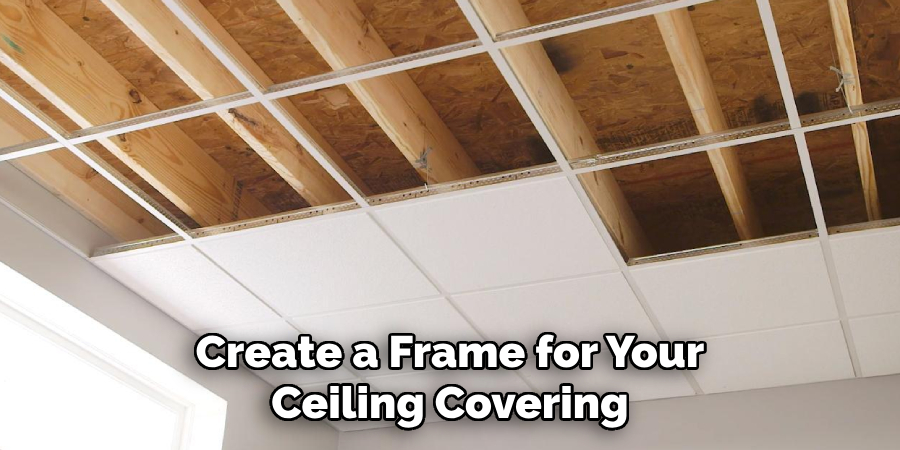
Furring strips are thin pieces of wood or metal that you’ll use to create a frame for your ceiling covering. They will be attached to the joists of your basement ceiling using screws. Make sure they are evenly spaced and flush with the joists.
Step 4: Install Insulation (Optional)
If your basement is not properly insulated, you may want to add insulation before installing the covering material. This will help with temperature control and noise reduction in the room above the basement.
Using your measurements from step 2, cut your chosen covering material to fit the dimensions of your basement ceiling. Follow the manufacturer’s instructions for installation, whether it be adhesive tiles or panels that require screws.
Step 5: Add Finishing Touches
Once the covering material is installed, add any finishing touches such as molding or trim to create a polished look. This step is optional but can add a nice touch to your newly covered basement ceiling.
Before completing the project, make sure to consider any lighting or ventilation fixtures that may need to be installed in your newly covered ceiling. This is especially important if you plan on using the basement as a living space.
Step 6: Clean Up and Enjoy
Once everything is installed and in place, take some time to clean up the area and admire your newly covered basement ceiling. You can now enjoy a more finished look in your basement space, whether it be for storage or living purposes.
By following these step-by-step instructions, you can successfully cover your basement ceiling and create a more functional and aesthetically pleasing space in your home. Remember to take the time to properly plan, measure, and choose your materials to ensure a successful project.
Safety Tips for How to Cover Basement Ceiling
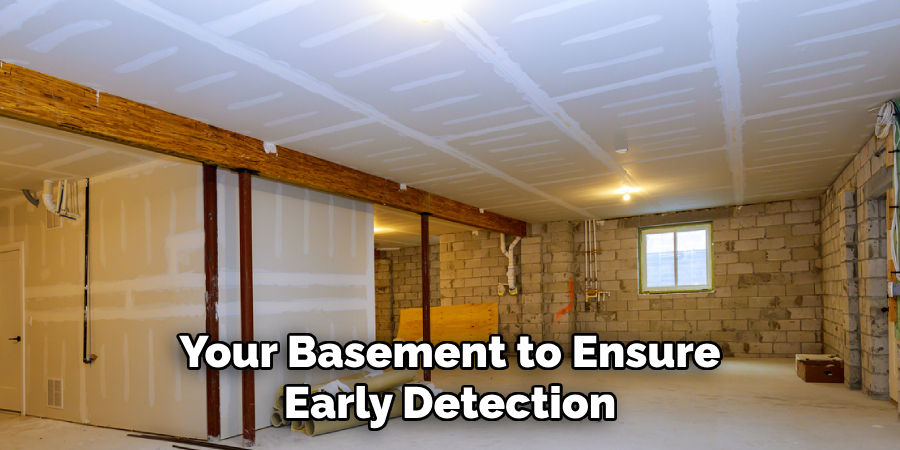
- Install smoke and carbon monoxide detectors in your basement to ensure early detection of any potential hazards.
- Use proper electrical wiring techniques when installing lights or outlets.
- Avoid storing combustible materials such as gasoline, paint thinner, or propane near the ceiling.
- Consider using fire-rated materials for insulation and finishing materials such as drywall, which can help prevent the spread of fire.
- Regularly check and maintain your basement’s ventilation system to prevent the buildup of harmful gases such as radon.
- If you plan on using the basement for recreational purposes, ensure that there is proper lighting to avoid accidents.
- Always have a fire extinguisher easily accessible in case of emergencies.
By following these safety tips, you can ensure that your basement ceiling is not only visually appealing but also safe for you and your family. In addition to these precautions, it is important to regularly inspect and maintain your basement ceiling to address any potential hazards or damages.
Are There Any DIY Options for Covering a Basement Ceiling?
Yes, there are several DIY options for covering a basement ceiling. Here are some ideas to consider:
- Paint the Ceiling: A simple and cost-effective option is to paint the ceiling with a neutral color or even a bold accent color. This can help cover up any imperfections and give your basement a fresh look.
- Install Ceiling Tiles: There are various types of ceiling tiles available, including drop-in, glue-up, and snap-together options. These can be easily installed and come in a variety of styles to match your basement’s aesthetic.
- Hang Fabric: For a unique and budget-friendly option, consider hanging fabric from the ceiling. This can add texture and interest to the space while also covering up any unsightly areas.
- Use Wood Planks: If you prefer a more rustic or farmhouse look, using wood planks to cover your basement ceiling can be a great option. These can be stained or painted to match your desired style.
- Install Beadboard Panels: Beadboard is a type of paneling that gives off a classic and traditional feel. It can easily be installed on a basement ceiling and can also provide additional insulation.
- Create a Stenciled Design: For those feeling creative, consider using stencils to create a unique design on your ceiling. This can be done with paint or even wallpaper for an added touch.
- Hang String Lights: To add some ambiance to your basement, hang string lights from the ceiling. This can create a cozy and inviting atmosphere while also covering up any unsightly areas.
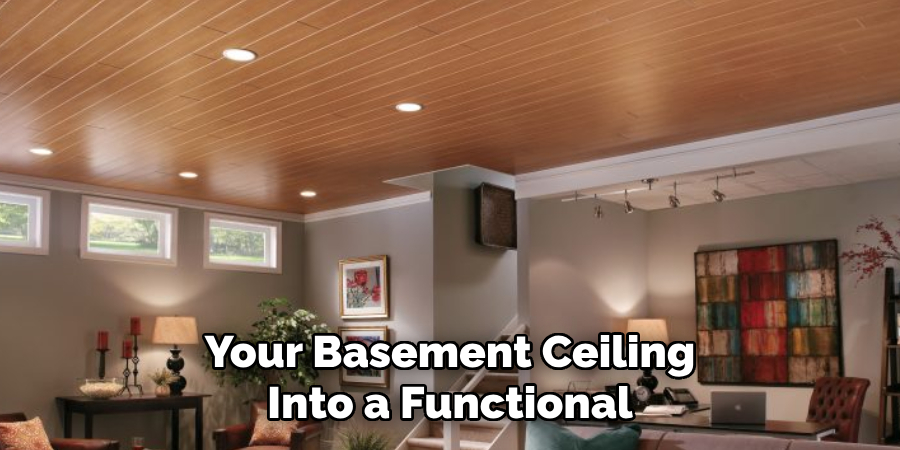
By considering these DIY options, you can transform your basement ceiling into a functional and visually appealing space. Just be sure to follow proper safety precautions and consult a professional if needed. With some creativity and effort, you can cover your basement ceiling in a way that fits your personal style and budget.
What Are Some Benefits of Covering a Basement Ceiling?
There are several benefits of covering a basement ceiling, including:
- Hiding Unsightly Wiring and Pipes: Basements typically have exposed wires and pipes running along the ceiling, which can be an eyesore. Covering the ceiling with drywall or panels can help hide these elements and make your basement look more polished.
- Better Insulation: Unfinished basements often have poor insulation, resulting in increased energy costs. By covering the ceiling with insulation and drywall or panels, you can improve the overall energy efficiency of your home.
- Soundproofing: If you use your basement as a living space or entertainment area, covering the ceiling can help reduce noise from upstairs areas. This is especially beneficial for homes with hardwood floors or thin walls.
- Enhanced Aesthetics: A finished basement with a covered ceiling looks more cohesive and complete compared to an unfinished one. It can also add value to your home and make it more appealing to potential buyers in the future.
- Easy Access for Maintenance: Covering the ceiling allows for easy access to wiring, pipes, and other systems that may require maintenance or repairs. This can save time and effort in the future.
- More Usable Space: By covering the ceiling, you are essentially creating an additional level or room in your home. This extra space can be used for storage, a home gym, a playroom for kids, or even as an extra bedroom.
- Protection Against Potential Hazards: In older homes, exposed pipes and wiring may contain hazardous materials such as asbestos or lead. Covering the ceiling can help prevent exposure to these substances and ensure the safety of your family.
- Added Fire Protection: A covered basement ceiling with fire-resistant materials can provide an extra layer of protection in case of a fire, reducing the risk of damage to your home and belongings.
- Better Temperature Control: A covered ceiling can help maintain a more consistent temperature in your basement, making it more comfortable for use throughout the year.
- Personalization: Covering your basement ceiling gives you the opportunity to add your personal touch and style to the space. You can choose from a variety of materials, colors, and designs to create a unique and inviting atmosphere.
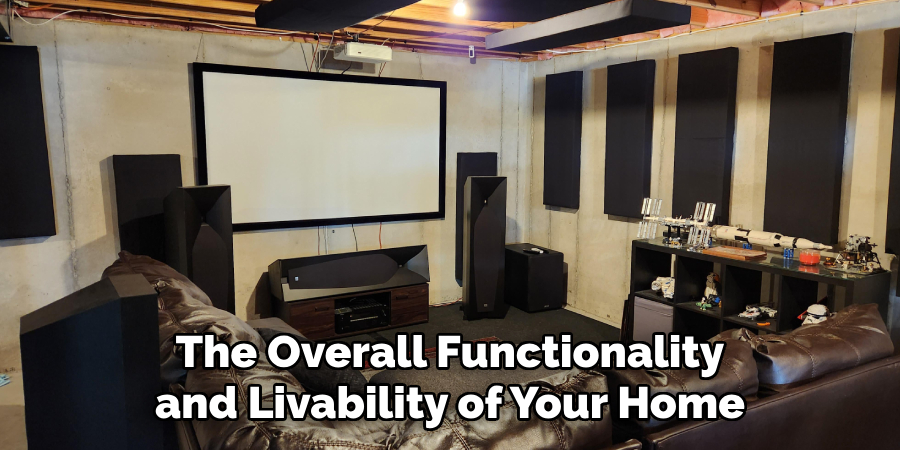
In addition to these benefits, covering a basement ceiling can also improve the overall functionality and livability of your home. It’s a relatively simple and cost-effective way to transform your unfinished basement into a functional and attractive space that you can enjoy for years to come.
What Are Some Design Ideas for a Covered Basement Ceiling?
There are so many ways to design a covered basement ceiling, but it ultimately depends on your personal style and the function of your space. Here are some design ideas that you may want to consider:
- Exposed Ductwork – If you have exposed ductwork in your basement, why not make it a part of your design? You can paint the ducts a fun color or wrap them in fabric for a more cozy look.
- Wood Paneling – For a rustic or industrial vibe, consider using wood paneling to cover your basement ceiling. It adds warmth and texture to the space.
- Painted Ceiling – Painting your basement ceiling is an easy and budget-friendly way to cover it up. You can choose a solid color or get creative and paint a pattern or design.
- Fabric Ceiling – If you want to add some interest to your basement ceiling, consider using fabric. You can drape it across the ceiling or create panels for a more structured look.
- Beadboard – For a classic and timeless look, consider using beadboard on your basement ceiling. It’s easy to install and adds a touch of elegance to the space.
- Suspended Ceiling – A suspended ceiling is a great option if you want easy access to your wiring and plumbing. Plus, it can easily hide any imperfections in your basement ceiling.
- Faux Tin Tiles – Add some character and charm to your basement with faux tin tiles on the ceiling. They come in various designs and colors, making it easy to find one that fits your style.
- Wallpaper – Wallpaper isn’t just for walls! Use a bold or textured wallpaper on your basement ceiling to make a statement.
- Stenciled Ceiling – If you have a steady hand and some patience, consider stenciling a design onto your basement ceiling. It’s a unique way to add some personality to the space.
- String Lights – For a whimsical and cozy feel, consider adding string lights to your basement ceiling. They can be used as a primary light source or as accent lighting.
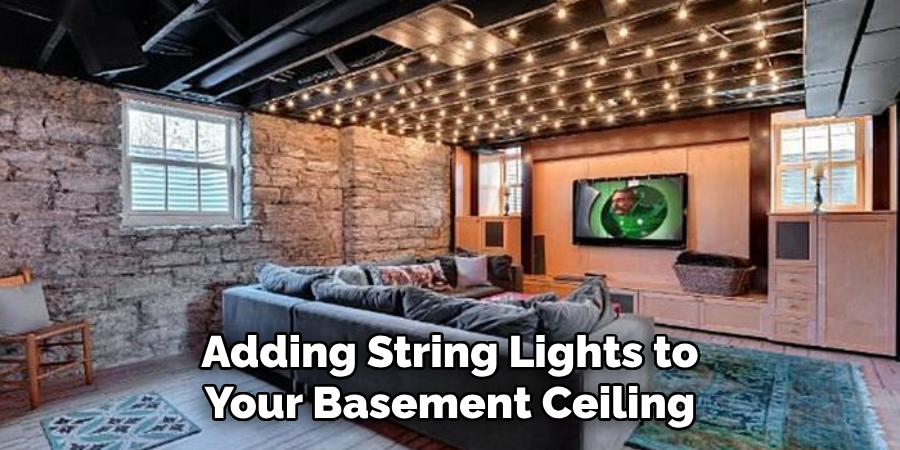
In addition to these design ideas, it’s important to think about practical considerations when covering your basement ceiling. If you have low ceilings, avoid dark colors or heavy materials that can make the space feel even smaller. Also, consider using materials that are easy to clean and maintain in case of any potential leaks or water damage.
How Can You Prevent or Address Any Moisture Issues When Covering Your Basement Ceiling?
Moisture can be a major concern when covering a basement ceiling, as basements tend to have higher levels of humidity and are susceptible to leaks or water damage. Here are some ways you can prevent or address moisture issues when designing your covered basement ceiling:
- Choose Moisture-resistant Materials – When selecting materials for your covered basement ceiling, opt for ones that are specifically designed to resist moisture. This can include materials like vinyl, PVC, or metal.
- Install Proper Insulation – Proper insulation in your basement ceiling can help regulate the temperature and reduce humidity levels. It also acts as a barrier for any potential leaks or water damage.
- Use Waterproof Sealants – If you have any exposed concrete or other porous surfaces on your basement ceiling, consider using a waterproof sealant to prevent moisture from seeping in.
- Install Proper Ventilation – Proper air circulation is key in preventing moisture buildup. Make sure your basement has adequate ventilation, whether it’s through windows or a ventilation system.
- Repair Any Leaks Promptly – If you do experience any leaks or water damage in your basement, make sure to address them as soon as possible. This can prevent further damage and mold growth.
- Use a Dehumidifier – If you live in an area with high humidity levels, consider using a dehumidifier in your basement to control moisture levels.
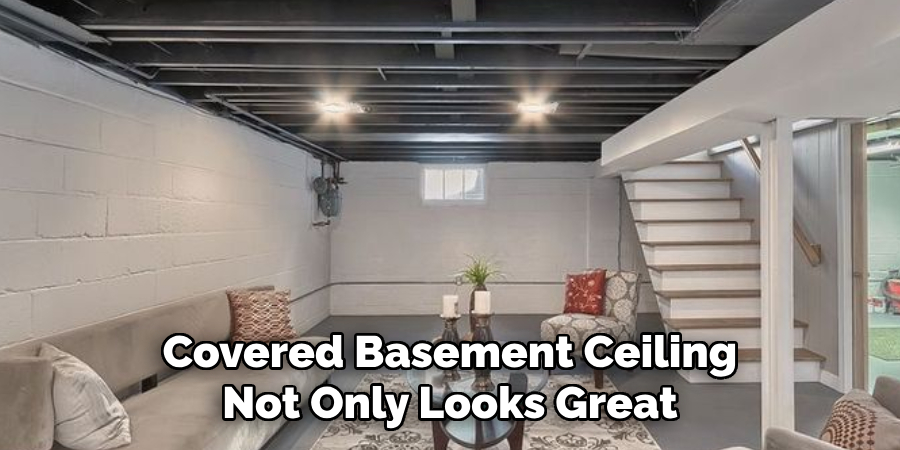
By taking these preventative measures, you can ensure that your covered basement ceiling not only looks great but also remains durable and free from any moisture issues. So, consider these tips when designing your covered basement ceiling to create a functional and stylish space. Remember to also regularly check for any signs of moisture or water damage to catch and address any issues early on.
Are There Any Recommended Professionals or Contractors That Specialize in Covering Basement Ceilings?
If you are not confident in your own DIY skills or would prefer to have a professional handle the job, there are several types of professionals and contractors that specialize in covering basement ceilings. Here are a few options to consider:
- General Contractors – A general contractor can oversee the entire project, including planning and hiring subcontractors if needed.
- Remodeling Contractors – These contractors specifically focus on remodeling projects and may have experience with covering basement ceilings.
- Ceiling Contractors – There are contractors who specialize in installing or repairing different types of ceilings, including those for basements.
- Handyman Services – If you just need a small portion of your basement ceiling covered, hiring a handyman service can be a cost-effective option.
- Interior Designers – If you want help selecting the best materials and design for your covered basement ceiling, an interior designer can provide valuable insight and assistance.

Be sure to do your research and ask for recommendations when choosing a professional or contractor to work on your covered basement ceiling. It’s important to find someone with experience and expertise in this specific area to ensure a quality job. With the right professional, you can achieve a beautifully covered basement ceiling that meets both your design and practical needs.
Conclusion
In conclusion, covering a basement ceiling can have its disadvantages, but the benefits far outweigh them. One of the main drawbacks is the cost and time involved in this project. Depending on the materials used and complexity of the design, covering a basement ceiling can be a significant investment. It also requires careful planning and execution, which may take up valuable time that could be spent on other home improvement projects.
However, when done correctly, covering a basement ceiling can transform an otherwise unfinished and uninviting space into a functional and visually appealing area of your home. It can also add value to your property and provide extra living or storage space. I hope this article has been beneficial for learning how to cover basement ceiling. Make Sure the precautionary measures are followed chronologically.
